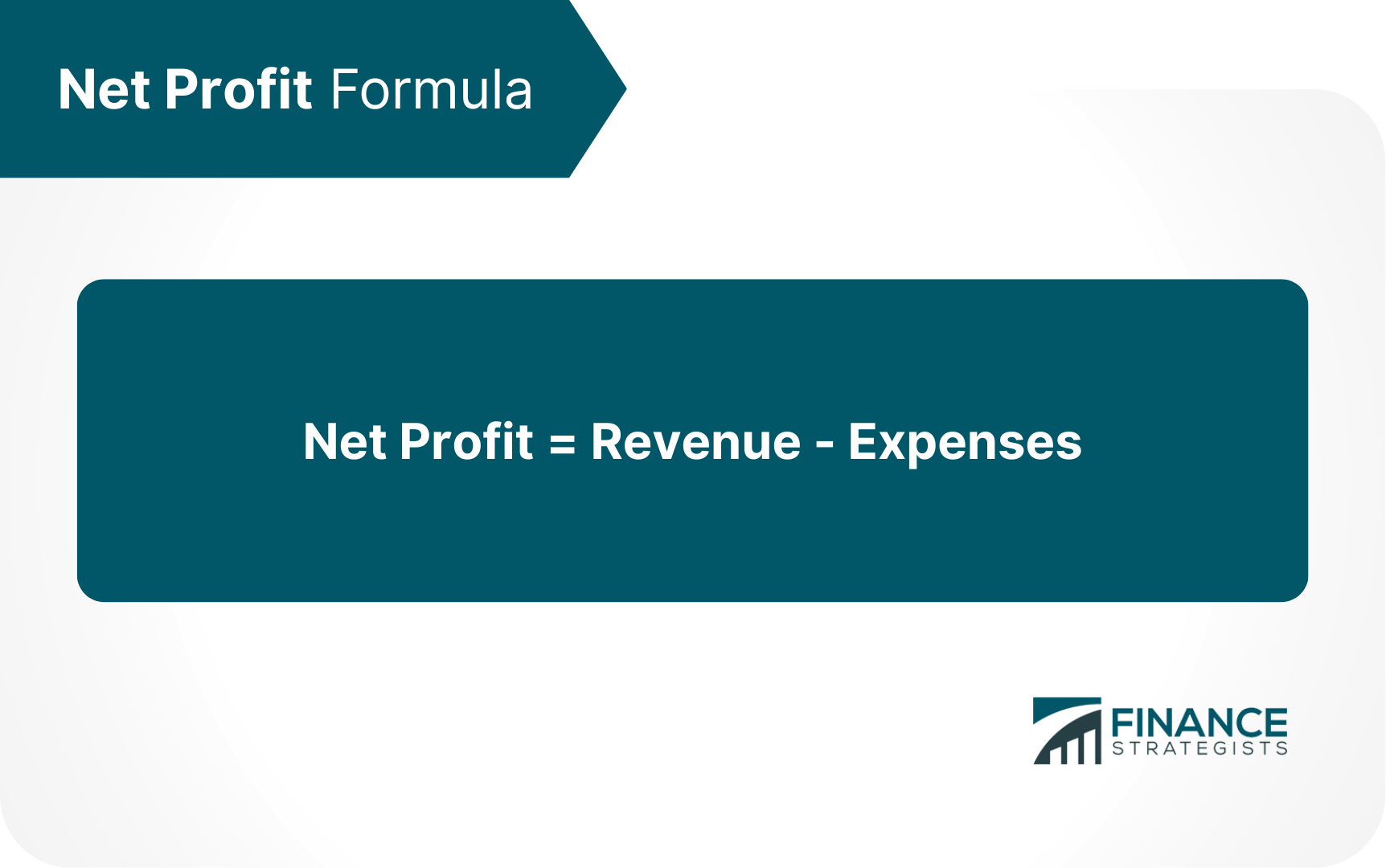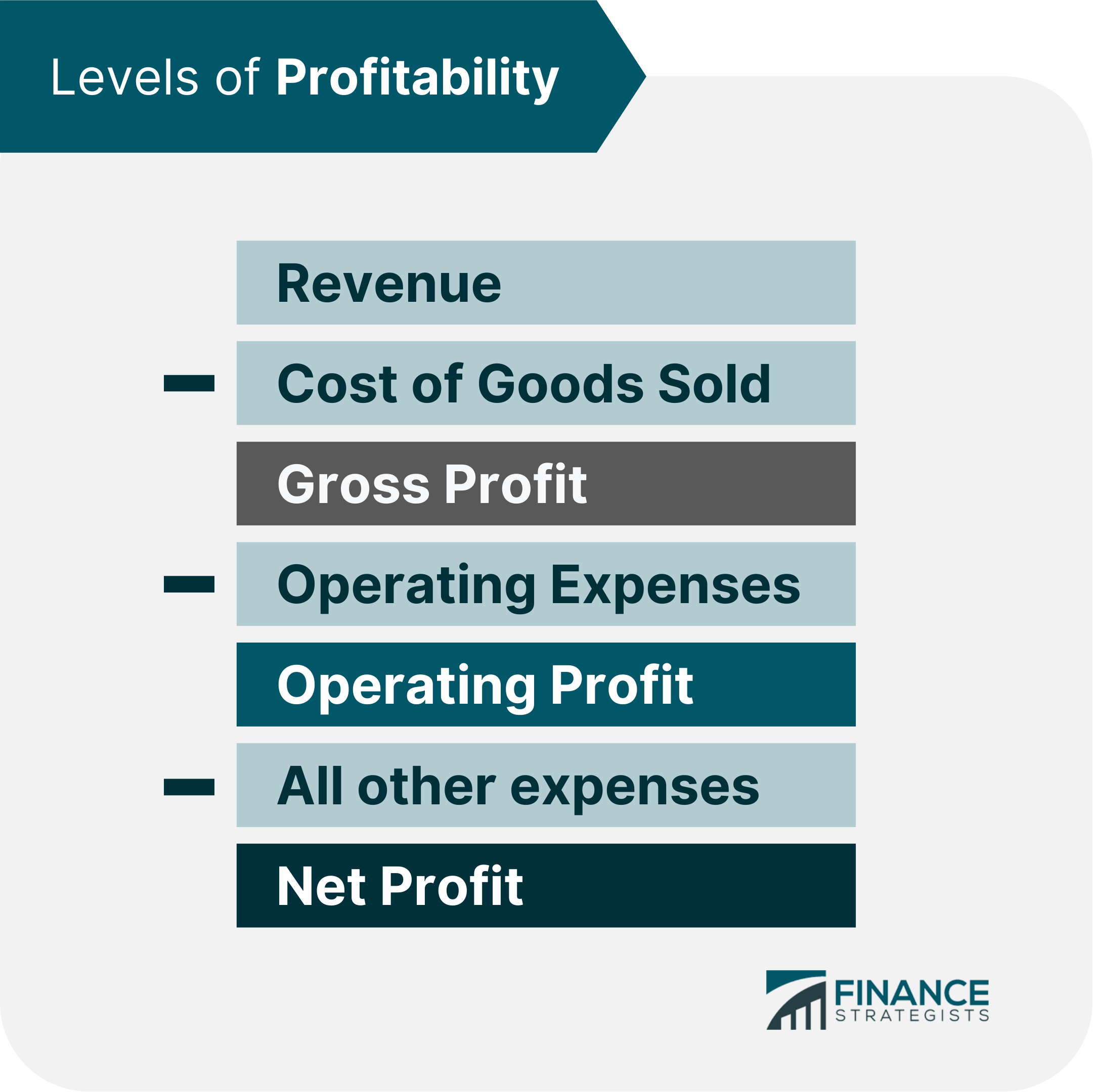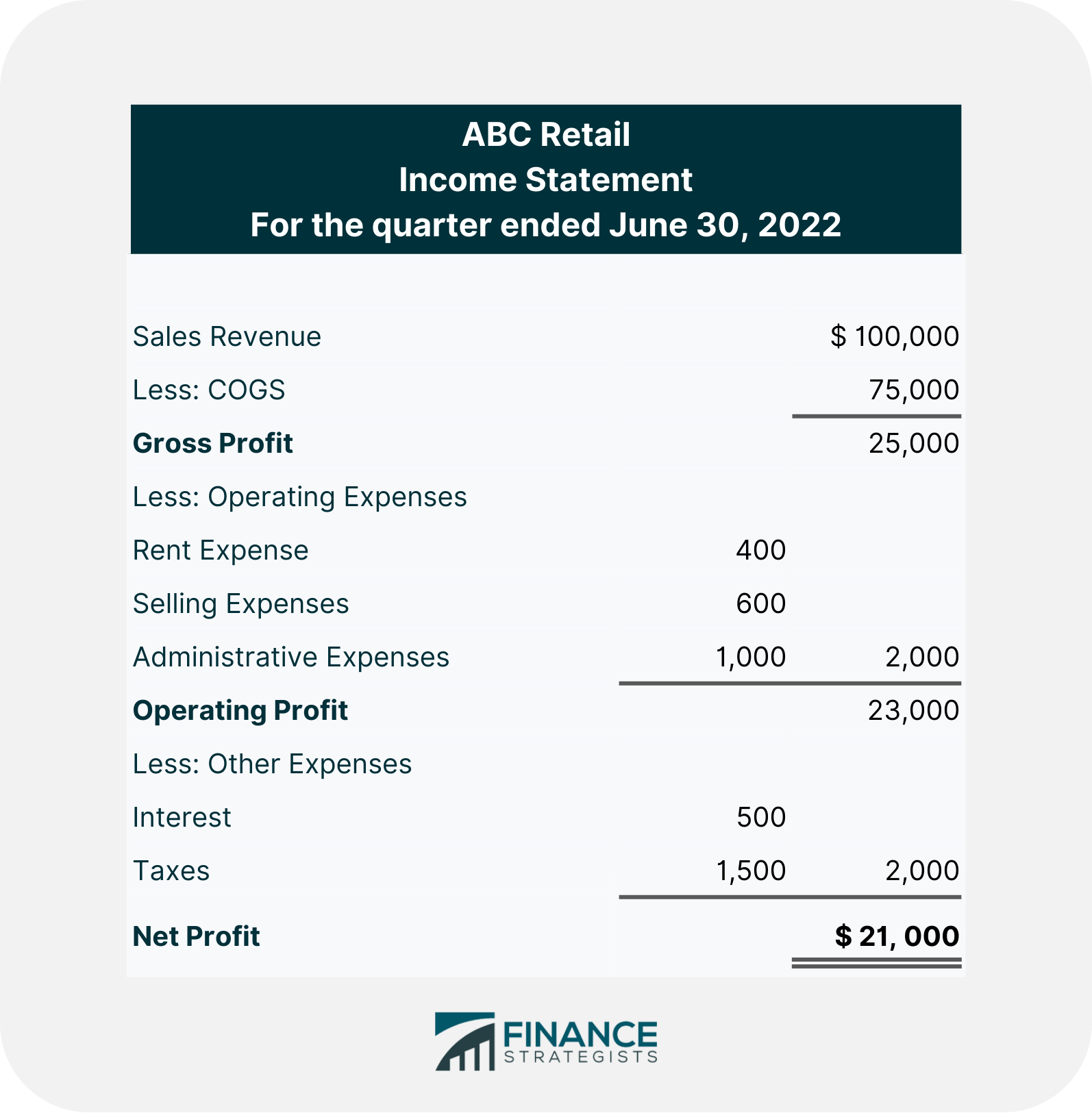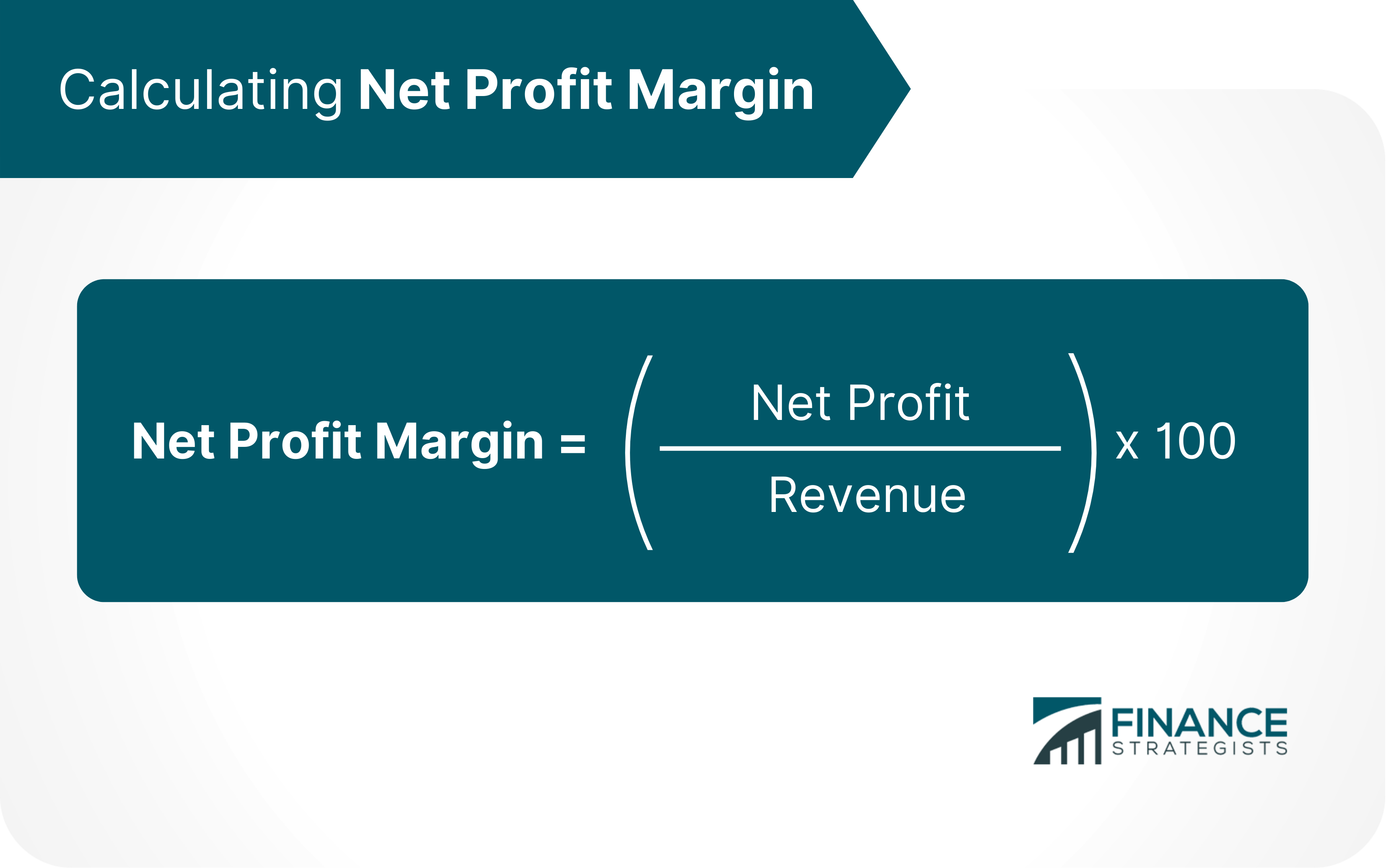Net profit refers to the amount of money left after all the expenses have been subtracted from revenues. Net profit is commonly referred to as the "bottom line" because it appears at the bottom portion of an income statement. It may also be called net income or net earnings. The net profit figure comprehensively displays the profitability of a business, and it is used in publicly traded companies to calculate their earnings per share (EPS). The formula for calculating net profit is: There are various levels of profitability before net profit is reached. First is gross profit, which subtracts only the cost of goods sold (COGS) from the total revenue. Because expenses that make up COGS, such as direct materials and direct labor, are inevitable expenses, investors consider gross profit a measure of a company’s overall ability to generate profit. Next is operating profit, which takes into account both the COGS and operating expenses such as employee payroll, rent, inventory costs, equipment, and the selling, general, and administrative costs (SG&A). It also subtracts depreciation and amortization of assets. Operating profit reveals how efficient the company is in controlling their operating costs or other factors that could influence revenue build-ups. Finally, net profit is the amount left after all other expenses have been paid, including taxes and interest. Net profit reveals the success of a business and its ability to repay debt and reinvest. Calculating profit on these three levels allows companies to examine which expenses take the most out of the bottom line. The main expenses that factor into net profit are as follows: COGS, also called cost of sales, refers to the direct costs incurred in producing any goods or services. It is considered a business expense on an income statement. COGS often appears as the second line item in an income statement, right after the revenue. It is subtracted from revenue to calculate gross profit. It includes the costs of raw materials, direct labor costs, freight-in costs, and direct factory overhead costs, such as utilities for the manufacturing site. Operating expenses, also referred to as operating expenditures, are expenses that a business incurs for its operational activities. When operating expenses increase, the net profit of a business decreases. They are the costs of running the business. Because they are fixed, they tend not to fluctuate with the sales volume. Items included in operating expenses are rent, salaries/wages for employees outside of production, business travel costs, property taxes, and research & development costs. Selling, general, and administrative (SG&A) expenses are also included in the operating expenses of a business. It consists of all the non-production costs, which some companies list as a separate line item. SG&A costs include marketing, sales, accounting, advertising, and promotional costs. Other expenses represent all the other expenses that are not part of COGS and operating expenses. Non-operating items, such as taxes, interest income and expenses, gains and losses from investments in other companies, and proceeds from sale of extraordinary items, are taken into account in determining net profit. Knowing how to calculate net profit is essential for business owners and investors. This helps manage the company's books more accurately and understand its overall profitability. Businesses should know and care about their net profit as it reveals their success. It also determines the money available to pay the owners and stockholders or the amount that could be invested back into the business. Calculating net profit is straightforward. Let us use the following illustration to clearly understand how it is done. ABC Retail sells strollers at $200 each. These were originally bought for $150 each. For the second quarter of 2022, it sold 500 strollers. It also incurred the following expenses: Here are the steps we need to take to calculate the net profit of the above illustration: Step 1: Determine total revenue Total revenue refers to the total amount of sales earned during the accounting period. To determine the total revenue, multiply the number of goods sold by the price of the goods. Revenue = Quantity Sold x Selling Price = 500 x $200 = $100,000 Step 2: Determine total expenses Total expenses are the sum of all costs spent on operating and running the business. These include COGS, operating expenses, and all other expenses. Cost of Goods Sold = Quantity Sold x Cost per Piece = 500 x $150 = $75,000 Operating expenses = Rent + Selling + Administrative = 400 + 600 + 1,000 = $2,000 All Other Expenses = Interest + Taxes = 500 + 1500 = $2,000 Total Expenses = 75,000 + 2,000 +2,000 = $79,000 Step 3: Subtract total expenses from total revenue Applying the net profit formula, subtract the total expenses from the total revenue. Net Profit = Total revenue - Total Expenses = $100,000 - $79,000 = $21,000 ABC Retail’s net profit amounts to $21,000. This means that the company has $21,000 left to reinvest in the business or pay its shareholders. Below is the income statement of ABC Retail: Net profit measures how much money remains after expenses are subtracted from revenue. Net cash flow corresponds to the amount of cash flowing in and out of a business during a specific period. They typically differ because of the two distinct accounting methods used by businesses to calculate them - accrual basis or cash basis. With the accrual basis method, revenue is recognized when it is earned rather than when it is received. On the other hand, the cash basis method only recognizes revenue and expenses when cash is exchanged. The accrual method is usually more accurate in matching revenue with the corresponding expenses incurred to generate that revenue. As a result, net profit is often different from net cash flow since it may include revenue that has not yet been received and expenses that have not yet been paid. In conclusion, net profit is a measure of profitability, while net cash flow is a measure of liquidity. They are both important indicators of a company's financial health but should be considered in conjunction with other financial ratios to get a complete picture. Net profit margin measures how much net profit is generated as a percentage of revenue. It shows the ratio of a net profit to its total revenue. It measures the value of net profit a company obtains per dollar of revenue collected. The higher the net profit margin, the more profitable the business is. Using the above example in net profit, let us calculate the net profit margin of ABC Retail. $21,000/$100,000 x 100% = 21% Thus, the company has a net profit margin of 21%. This means that the company generates 21 cents of net profit for every dollar of revenue. There are various ways a business can increase its net profit: Consider removing products or services that are not yielding a profit. Doing so ensures you are not wasting shelf space or any costs associated with carrying that product. Review your inventory on a regular basis and get rid of any items that are not selling or are not profitable. A minimal price adjustment may be all you need to increase your net profit. Applying pricing strategies with the current market status in mind will help you optimize your pricing for higher net profit and customer retention. Be sure to conduct market research to ensure that your prices are in line with what customers are willing to pay. If you manufacture products or resell items, you may be able to reduce COGS. For example, if you are a retailer, you may be able to negotiate better terms with your supplier or find a cheaper source for the products you sell. If you are a manufacturer, you may be able to reduce production costs by streamlining your process or using cost-efficient materials. You may be able to increase your net profit by reducing the costs associated with running your business. Review your monthly expenses and examine where you can cut back, such as on office supplies, marketing costs, or travel expenses. Net profit is the money a company earns after deducting all expenses from revenue. While often misconstrued to be the same, net profit and net cash flow are different from each other. They usually differ because of the accounting methods applied by companies which are either on an accrual basis or a cash basis. Net profit margin is the ratio of net profit to total revenue, expressed as a percentage. There are various ways businesses can increase their net profit, such as reducing unprofitable products or services, conducting market research to review pricing, or reducing direct and overhead costs. Net profit is a key metric that businesses use to measure their financial performance. By understanding the definition, formula, and factors affecting net profit, as well as how to calculate it, you can get a better sense of your business's bottom line.What Is Net Profit?
Net Profit Formula

Expenses That Factor Into Net ProfitCOGS
Operating Expenses
Other Expenses
Calculating Net Profit

Net Profit vs. Net Cash Flow
Net Profit Margin

How to Improve Net Profit
Removing Unprofitable Goods or Services
Reviewing Pricing
Reducing Direct Costs
Reducing Overhead Costs
The Bottom Line
Net Profit FAQs
Gross profit is the revenue a company earns minus the cost of goods sold. Net profit is the revenue minus cost of goods sold, operating expenses, and all other expenses incurred by the business.
Net profit is a key metric because it shows whether a company is generating enough revenue to cover its expenses. Knowing net profit will help businesses see how well or how bad they are performing. It will aid in decision-making, such as whether to raise prices or cut costs with the core aim to improve profitability.
Net profit is calculated by subtracting all expenses from revenue.
There are various ways businesses can increase their net profit, such as reducing unprofitable products or services, conducting market research to review pricing, or reducing direct and overhead costs.
Net profit margin is the ratio of net profit to total revenue, expressed as a percentage. Net profit margin can be used to compare the financial performance of different companies or industries because it shows how much profit a company makes for every dollar of revenue.
True Tamplin is a published author, public speaker, CEO of UpDigital, and founder of Finance Strategists.
True is a Certified Educator in Personal Finance (CEPF®), author of The Handy Financial Ratios Guide, a member of the Society for Advancing Business Editing and Writing, contributes to his financial education site, Finance Strategists, and has spoken to various financial communities such as the CFA Institute, as well as university students like his Alma mater, Biola University, where he received a bachelor of science in business and data analytics.
To learn more about True, visit his personal website or view his author profiles on Amazon, Nasdaq and Forbes.















